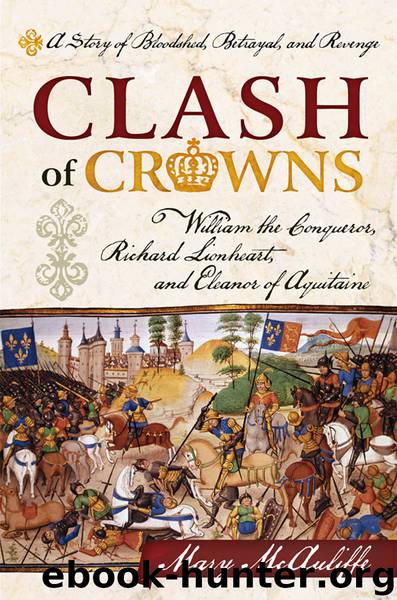Clash of Crowns by Mary McAuliffe

Author:Mary McAuliffe
Language: eng
Format: epub
ISBN: 9781442214736
Publisher: Rowman & Littlefield Publishers
Published: 2016-04-30T16:00:00+00:00
In the meantime, Richard and his mercenary henchman, Mercadier, had been pressing Philip hard to the south of Paris, in Berry and the Auvergne. This, as well as Henry Hohenstaufen’s worrisome meddling, may have prompted the Vaudreuil parley, for discussions between the enemies continued even as they continued to bash away at one another. Although Clausewitz famously observed that modern warfare is merely the continuation of political policy by other means, the twelfth century seems to have reversed this dictum, at least where diplomacy was concerned. Opposing sides used these frequent diplomatic time-outs to catch their breath, evaluate their enemy’s strength and determination, and reconfigure the chessboard to their advantage, all the while taking every opportunity to undermine the opposition’s morale.
The stops and starts of this era’s warfare may have originated in the rhythms of the feudal levy, which typically lasted forty days. Traditionally, in return for lands held, the feudal vassal owed his lord the service of an agreed-upon number of armed and mounted knights for forty days each year. In years gone by, this amount of military service had been sufficient to keep the fires of war burning throughout the length and breadth of Western Christendom during the entire fighting season, which generally began after Easter.
Yet by the late twelfth century, lords and kings such as Richard and Philip required service for far greater lengths of time than the feudal levy by itself made possible. The rise of towns and communal militias provided little direct help, for a town’s carefully hammered out privileges often precluded anything other than outright defense. The burgesses of Andely, for example, were required to serve only on expeditions that left and returned on the same day. That left the lord with lengthy military requirements to bargain as best he could with his vassals, such as requiring fewer knights for longer periods of time. Ultimately, warring lords increasingly turned to hiring mercenary forces—that is, professional soldiers of humble origins who fought for pay.22
Money had in fact by this time become essential to warfare.23 Paid soldiers were proving indispensable, not only in drawn-out conflicts such as the one in which Richard and Philip were engaged, but also in permanently garrisoning those fortresses of particular importance along volatile frontiers. Not all soldiers receiving pay were of humble origin, for as knights extended their military service, they too received money payment.
Wages for military service, however, were high. Six shillings per day, Angevin coinage, was not uncommon for a knight, while a mounted man-at-arms (not a knight) typically received two shillings and sixpence, and the common foot soldier, eight pence.24 These wages were impressive, even if calculated in the money of Anjou—the copper-debased silver coinage used in Normandy at the time, valued at only a quarter of English sterling. When one realizes that a Norman during those years could buy a chicken for a penny and an entire ram for a shilling, even the foot soldier’s wages were considerable. Yet with wages so high, even kings could not afford to maintain large permanent armies.
Download
This site does not store any files on its server. We only index and link to content provided by other sites. Please contact the content providers to delete copyright contents if any and email us, we'll remove relevant links or contents immediately.
| General | Channel Islands |
| England | Northern Ireland |
| Scotland | Wales |
Room 212 by Kate Stewart(5067)
The Crown by Robert Lacey(4760)
Endurance: Shackleton's Incredible Voyage by Alfred Lansing(4715)
The Iron Duke by The Iron Duke(4318)
The Rape of Nanking by Iris Chang(4165)
Joan of Arc by Mary Gordon(4051)
Killing England by Bill O'Reilly(3968)
Say Nothing by Patrick Radden Keefe(3936)
I'll Give You the Sun by Jandy Nelson(3393)
Shadow of Night by Deborah Harkness(3324)
Hitler's Monsters by Eric Kurlander(3289)
Mary, Queen of Scots, and the Murder of Lord Darnley by Alison Weir(3170)
Blood and Sand by Alex Von Tunzelmann(3164)
Eleanor & Park by Rainbow Rowell(3105)
Darkest Hour by Anthony McCarten(3095)
Margaret Thatcher: The Autobiography by Thatcher Margaret(3045)
Book of Life by Deborah Harkness(2891)
Red Famine: Stalin's War on Ukraine by Anne Applebaum(2890)
The One Memory of Flora Banks by Emily Barr(2829)
